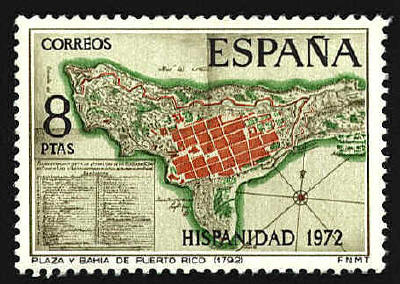|
San Juan, Puerto Rico ~ 1792
The
island of Puerto Rico was discovered by Columbus in 1492. It was a
colony of Spain until 1898 when it was invaded by the United States.
The stamp shows the square and bay of San Juan, Puerto Rico as it
appears on a map from 1792.

Zaragosa ~ after 1681
Near
the end of the first century, under Augustus, the Romans captured the
town of Salduba and established a military camp. The name of the camp
was Caesar Augustus, Saraqustah in Arabic, and Zaragosa in
Spanish. The Roman camp at the site of Zaragosa is shown on the stamp.
The Cardo Maximo and the Ducumano Maximo, the major
intersecting streets of the camp are identified. The muralla is
a section of the wall that enclosed the camp.

Several
architectural landmarks from the period following the expulsion of the
Moors from Zaragosa in the twelfth century are also indicated.
Mosaicos indicates the presence of mosaic pavements; Toro
is the central square; Teatro is the theater; Pilar is
short for Cathedral of Our Lady of the Pillar, 1681; Seo
is the twelfth century Catedral de la Seo; PET, PIEDRA,
the seven arched bridge over the River Ebro, built in the
mid-fifteenth century; Lonja, the palace of the Counts of Luna,
also fifteenth century.
The stamp was issued in 1975 to celebrate the second
millennium of Zaragosa, the capital of Zaragosa Province in the
autonomous community of Aragon, Spain.
Las Palmas de Gran Canaria ~
18th Century
Las
Palmas is the capital of Las Palmas Province and the largest city of
Gran Canaria Island in the Canary Islands. It was founded in 1478 at
the mouth of a ravine, and named for the palm trees that were abundant
there. Las Palmas was the headquarters for the Spanish conquest of
Tenerife and La Palma Islands, and later was an important supply base
for Spanish ships headed for the Americas. Christopher Columbus' house
is found in the colonial quarter.
The map is based on a plan of the town drawn in 1590 by
Leonardo Torriani, Descrittione et Historia del Regno de L'Isole
Canarie.

Ciudadela de Pamplona
In 1515
Navarra became a kingdom with its own institutions and laws under the
Castilian crown. In 1571 the Ciudadela or Fortress of Pamplona, the
capital, was built on the Pyrenean border. In the 19th century French
troops captured the Fortress by trickery and remained until 1813.

Santa Fe
The souvenir sheet was
issued in 1991 to mark the 500th anniversary of the end of Islamic
power in Spain. and to recognize the World Wide Philatelic Exposition
in Granada, Spain.
Ferdinand and Isabel set up camp in 1483 at the start
of the Siege of Granada. In 1491, in a period of 80 days, they
converted the camp into a town of brick and mortar, surrounded by a
wall and a moat, Santa Fe.
The structure of the town is that of a Roman camp built
round two straight roads that cross at the center. The four gates to
the city can still be seen today.
The contract between the King and Christopher Columbus
was signed here on 17th April 1492.
http://granadainfo.com/lorca/santafe.htm
November 26, 2001
The slogan on the stamp is
“Santa Fe, cradle of Spanish culture.”



|
